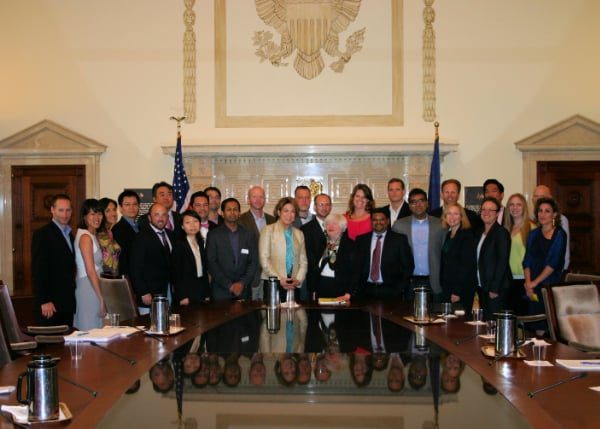Special journal issue celebrates 20 years of open innovation
Two years ago, Alex Severin, MBA 20, worked on a team that had been called on to build an innovation lab for a professional services firm operating in aviation and commercial energy markets.
With no corporate manual outlining an approach for building it, Severin, a management consultant, worked around the clock to help found Spark Labs. The lab, which now has 15 employees, helps clients tackle the “hairiest, cross-disciplinary challenges,” while teaching their employees and leaders about the “innovation mindset,”—which for many is hard to define, he said.
“Innovation is the most overused word in the English language,” he said. “You have all these large organizations saying, ‘This is the time we need to start investing in innovation,’ but nothing ever comes of it except giving Wall Street this impression that they’re investing. It amounts to little more than innovation theater.”

Alex Severin was drawn to study design thinking after founding an innovation lab as a consultant.
That experience hooked Severin on innovation, leading him to Haas, where he’s studying design thinking—a human-centered process for creative problem solving. Getting to the bottom of how to get the design thinking process right in companies is his mission and the subject of his new research, which will be presented at a Design Management Institute’s Academic Design Management Conference August 3-7.
Haas was an early pioneer in integrating design thinking into the MBA curriculum, with a course called Design as a Strategic Business Issue debuting in 1993. Teaching Professor Sara Beckman launched the Problem Framing, Problem Solving (PFPS) course in Fall 2010, a core course that evolved into Fundamentals of Design Thinking, organized by Professional Faculty members Clark Kellogg and Dave Rochlin through the Institute for Creativity and Design Practice. The class gives students an appreciation for how to frame and solve problems, leveraging tools and methods from design and systems thinking.
To go deeper into innovation, Severin launched an independent study last year with another Haas design thinking expert, lecturer Vivek Rao, exploring how large organizations use both design-based innovation activities and labs. For the project, Severin conducted interviews, mostly by video, with 19 high-level innovation executives from 14 companies in sectors including energy, education, healthcare, consumer electronics, and professional services.
A commitment to deep, critical thinking
The study resulted in a research paper, which Severin wrote with Rao.
“I think it’s remarkable that a full-time MBA candidate like Alex is producing publishable research,” Rao said, noting that research is usually the domain of PhD students. “The rigorous curriculum and extracurricular demands at Haas often leave little time for scholarly research. That Alex was able to do this is evidence of his commitment to deep, critical thinking.”
That Alex was able to do this is evidence of his commitment to deep, critical thinking.
The innovation community is small, which helped Severin convince leaders of the importance and broad applicability of his research. “Once people knew that they would get a copy of this report, they were more than happy to speak candidly,” he said. “People were willing to talk in a way I haven’t experienced in other research projects. They understand that this is a very hard thing to do right, so that creates a willingness to chat.”
The deep interviews led to five best design thinking practices:
Set the right expectations through strategic pilot projects immediately following launch. “Quick wins help get people on board,” Severin said. Make sure that the pilot outcome is easy for everyone at the company to understand so you can say, “Hey, we piloted this and look at the change,’” he said.
Establish a shared set of metrics with the business units to build buy-in and quickly create trust.
Seek deep company experience in innovation team leaders; seek external perspectives in all other roles. Every successful innovation team had a person in charge with deep company experience, he said. “Trust is so important,” he said. “If you come in as a hotshot off the street there’s no trust that exists from the start.”
Don’t fall in love with your framework. The most successful design and innovation teams sell tangible outcomes, not branded frameworks. “The sad truth is that few really care about the intricacies of your framework,” he says. “All they care about is what it means for them, and what the expected outcomes are. Speak their language, don’t expect them to learn yours.”
Stand up separate centralized and embedded teams with distinct missions to fulfill the mandate of corporate innovation teams. “The most effective application of a centralized team is an ‘A Team’ attached to the meatiest, most complex opportunities,” Severin said. Conversely, embedding a few people within the organization’s different business units promotes more precise work, better relationships, and a straighter path to successful democratization of innovation, he said.
Posted in:
Topics:



